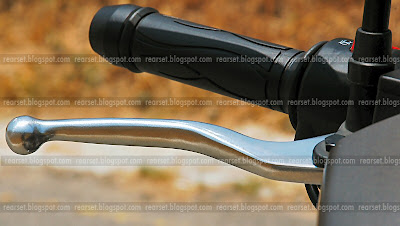TVS Apache RTR FI: The 160 gets fuel injection!
 The pic is the old Apache. You see, the the RTR FI only sports a new set of stickers to separate it from the normal carburetted RTR. The other difference visually being the optional rear disc should you opt for one. The price difference has not been announced but I would put the estimate at between Rs 3,000 (brilliant pricing) and Rs 5,000 (all right). The extra money goes towards even better midrange and top-end and very, very crisp throttle response. The launch is expected to arrive and capture the Diwali rush.
The pic is the old Apache. You see, the the RTR FI only sports a new set of stickers to separate it from the normal carburetted RTR. The other difference visually being the optional rear disc should you opt for one. The price difference has not been announced but I would put the estimate at between Rs 3,000 (brilliant pricing) and Rs 5,000 (all right). The extra money goes towards even better midrange and top-end and very, very crisp throttle response. The launch is expected to arrive and capture the Diwali rush.
The new Apache EFI
TVS Motor Company is for the first time offering Electronic Fuel Injection technology in the 160cc category. The new technology, which consists of an Electronic Control Unit (ECU) made up of sensors, fuel pump and injector. ECU receives the data from sensors, processes them and delivers optimum fuel and ignition timing. The Electronic Fuel Injection technology offers better engine smoothness, faster throttle response, lower emissions, good cold start and recovery, better idle stability, good drivability, better fuel economy and performance consistency at various altitudes and environments. The Apache RTR EFI also offers instantaneous response throughout the rev range. Another first time offering in this segment would be the rear disc brake facility.
Product specification
Engine
Displacement 159.7cc
Engine technology EFI, 4 Stroke
Max. Power (Kw@rpm) 11.54kw @ 8500 ( 15.7bhp @ 8500 )
Max. Torque (Nm@rpm) 13.1 Nm @ 6500
Gear Box 5 Speed constant mesh
Clutch Multi-Plate Wet Type
Bore x stroke (mm) 62x 52.9
Compression Ratio 9.5:1
Fuel system Electronic Fuel injection
Wheels & Tyre
Wheel Type Diecast Alloy
Tyre Front 90 x 90 - 17, Rear 100 X 80 - 18
Brakes
Brake - Front Dia 270 disc brake, petal type
Brake - Rear Drum 130 dia, Optional Rear Disk brake
Suspension
Front Telescopic Hydraulic fork, Rear Mono tube 5 step adjustable Canister - Gas filled shock absorbers
Electricals
Head lamp 12V 35/35W Halogen HS1, Clear lens with MFR
Tail lamp 12V 0.5 W. LED-Twin triangle with prism on lens
Turn signal lamp 12V 10W
Battery type & capacity 12V, 9.0 Ah
Ignition system High energy IDI System
Dimensions
Height 1100 mm
Length 2020 mm
Width 730 mm
Wheelbase 1300 mm
Ground Clearance 180mm
Kerb weight 136 kgs
Fuel Tank Capacity 16.0 Litre
Fuel reserve (lts) NOT APPLICABLE
Performance
Max speed 120 kph
TVS Apache RTR FI: The 160 gets fuel injection!
 The pic is the old Apache. You see, the the RTR FI only sports a new set of stickers to separate it from the normal carburetted RTR. The other difference visually being the optional rear disc should you opt for one. The price difference has not been announced but I would put the estimate at between Rs 3,000 (brilliant pricing) and Rs 5,000 (all right). The extra money goes towards even better midrange and top-end and very, very crisp throttle response. The launch is expected to arrive and capture the Diwali rush.
The pic is the old Apache. You see, the the RTR FI only sports a new set of stickers to separate it from the normal carburetted RTR. The other difference visually being the optional rear disc should you opt for one. The price difference has not been announced but I would put the estimate at between Rs 3,000 (brilliant pricing) and Rs 5,000 (all right). The extra money goes towards even better midrange and top-end and very, very crisp throttle response. The launch is expected to arrive and capture the Diwali rush.
The new Apache EFI
TVS Motor Company is for the first time offering Electronic Fuel Injection technology in the 160cc category. The new technology, which consists of an Electronic Control Unit (ECU) made up of sensors, fuel pump and injector. ECU receives the data from sensors, processes them and delivers optimum fuel and ignition timing. The Electronic Fuel Injection technology offers better engine smoothness, faster throttle response, lower emissions, good cold start and recovery, better idle stability, good drivability, better fuel economy and performance consistency at various altitudes and environments. The Apache RTR EFI also offers instantaneous response throughout the rev range. Another first time offering in this segment would be the rear disc brake facility.
Product specification
Engine
Displacement 159.7cc
Engine technology EFI, 4 Stroke
Max. Power (Kw@rpm) 11.54kw @ 8500 ( 15.7bhp @ 8500 )
Max. Torque (Nm@rpm) 13.1 Nm @ 6500
Gear Box 5 Speed constant mesh
Clutch Multi-Plate Wet Type
Bore x stroke (mm) 62x 52.9
Compression Ratio 9.5:1
Fuel system Electronic Fuel injection
Wheels & Tyre
Wheel Type Diecast Alloy
Tyre Front 90 x 90 - 17, Rear 100 X 80 - 18
Brakes
Brake - Front Dia 270 disc brake, petal type
Brake - Rear Drum 130 dia, Optional Rear Disk brake
Suspension
Front Telescopic Hydraulic fork, Rear Mono tube 5 step adjustable Canister - Gas filled shock absorbers
Electricals
Head lamp 12V 35/35W Halogen HS1, Clear lens with MFR
Tail lamp 12V 0.5 W. LED-Twin triangle with prism on lens
Turn signal lamp 12V 10W
Battery type & capacity 12V, 9.0 Ah
Ignition system High energy IDI System
Dimensions
Height 1100 mm
Length 2020 mm
Width 730 mm
Wheelbase 1300 mm
Ground Clearance 180mm
Kerb weight 136 kgs
Fuel Tank Capacity 16.0 Litre
Fuel reserve (lts) NOT APPLICABLE
Performance
Max speed 120 kph
















